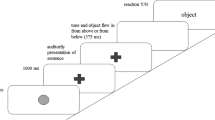Abstract
Forty-eight children at four age levels (3, 4, 5, and 7 years) acted out active and passive sentences immediately after exposure to matching information, mismatching information, and no-information cues. The matching information cues yielded the highest comprehension scores, followed in order by the no-information and the mismatching information cues. Active sentences were easier to comprehend than passive sentences, and comprehension scores improved with age. Processing context information in the form of role saliency cues is a component of children's language comprehension and development. It was found that context is used differentially depending on age and linguistic knowledge. The results indicated that the analysis of children's comprehension skills is a multifaceted process not solely dependent upon syntactic processing.
Similar content being viewed by others
References
Bever, T. G. The cognitive basis for linguistic structues. In J. R. Hayes (Ed.),Cognition and the development of language. New York: Wiley, 1970.
Chapman, R. S., & Kohn, L. L. Comprehension strategies in two and three-year-olds: animate agents or probable events.Journal of Speech and Hearing Research, 1978,21, 746–761.
Chomsky, C.The acquisition of syntax in children from 5 to 10. Cambridge: M.I.T. Press, 1969.
Clark, H. H., & Clark, E. V..Psychology and language: An introduction to psycholinguistics. New York: Harcourt Brace Jovanovich, 1977.
de Villiers, J. G., & de Villiers, P. A., Development of the use of word order in comprehension.Journal of Psycholinguistic Research, 1973,2, 331–341.
Fraser, C., Bellugi, U., & Brown, R., Control of grammar in imitation, comprehension, and production.Journal of Verbal Learning and Verbal Behavior, 1963,2, 121–135.
Gourley, J. W., & Catlin, J. Children's comprehension of grammatical structures in context.Journal of Psycholinguistic Research, 1978,7, 419–434.
Hutson, B. A., & Powers, J. Reversing irreversible sentences: Semantic and syntactic factors.Journal of Reading Behavior, 1974,6, 99–110.
Huttenlocher, J., Eisenberg, K., & Strauss, S. Comprehension: Relation between perceived actor and logical subject.Journal of Verbal Learning and Verbal Behavior, 1968,7, 527–530.
Huttenlocher, J., & Strauss, S. Comprehension and a statement's relation to the situation it describes.Journal of Verbal Learning and Verbal Behavior, 1968,7, 300–304.
Lempert, H. Extrasyntactic factors affecting passive sentence comprehension by young children.Child Development, 1978,49, 694–699.
Maratsos, M. P. Children who get worse at understanding passive: A replication of Bever.Journal of Psycholinguistic Research, 1974,3, 65–74.
Maratsos, M. P., & Abramovitch, R. How children understand full, truncated, and anomalous passives.Journal of Verbal Learning and Verbal Behavior, 1975,14, 145–157.
Sinclair, H., & Bronckart, J. P. S. V. O. A linguistic universal? A study in developmental psycholinguistics.Journal of Experimental Child Psychology, 1972,14, 329–348.
Strohner, H., & Nelson, D. E. The young child's development of sentence comprehension: Influence of event probability, nonverbal context, syntactic form and strategies.Child Development 1974,45, 567–576.
Wetstone, H. S., & Friedlander, B. Z. The effect of word order on young children's responses to simple questions and comments.Child Development, 1973,44, 734–740.
Author information
Authors and Affiliations
Rights and permissions
About this article
Cite this article
Hargrove, P.M., Panagos, J.M. Role saliency cues and children's sentence comprehension. J Psycholinguist Res 11, 217–228 (1982). https://doi.org/10.1007/BF01067565
Received:
Issue Date:
DOI: https://doi.org/10.1007/BF01067565




